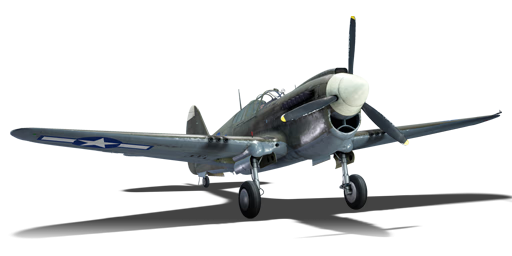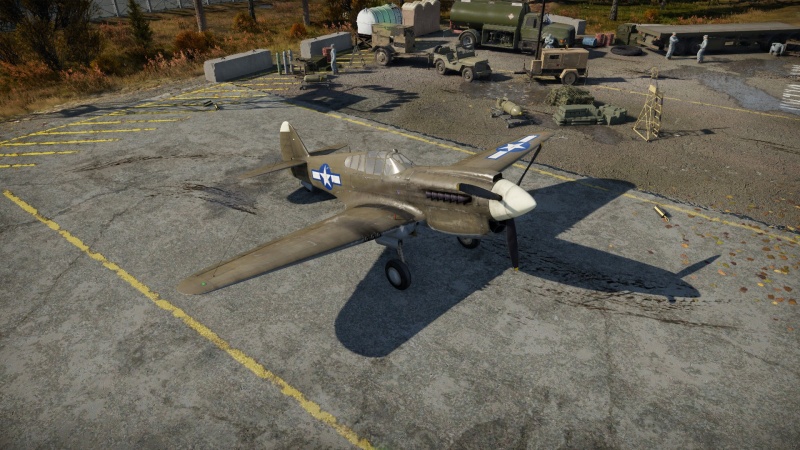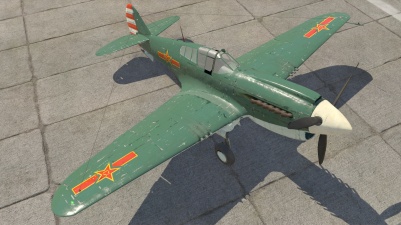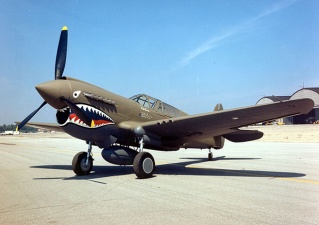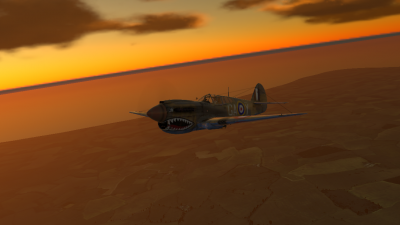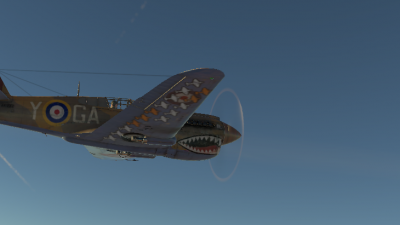Difference between revisions of "P-40E-1"
(→Details) |
(→In-game description: Reformatted) |
||
| Line 243: | Line 243: | ||
The P-40 was inferior to some German single-engine fighters in high-altitude combat due to its lack of a two-stage supercharger. This caused the P-40 to be rarely used in operation in Northwest Europe. But between the years of 1941 and 1944, the P-40 played a critical role in the theatres North Africa, the Southwest Pacific, and China. It also had a considerable role in the Middle East, Southeast Asia, Eastern Europe, Alaska, and Italy. The P-40's bad high-altitude performance did not matter in these theatres, where it was used as an air superiority fighter, bomber escort, and a fighter-bomber. Although the design was considered mediocre in postwar, suitable for only close air support, Allied pilots reported the P-40 flew surprisingly well as an air superiority fighter. The P-40 also had the advantage of low-cost assembly, which kept it in production as a ground-attack aircraft long after it was considered obsolete as a fighter. A survey conducted in 2008 showed that at the time, 29 P-40s were airworthy. | The P-40 was inferior to some German single-engine fighters in high-altitude combat due to its lack of a two-stage supercharger. This caused the P-40 to be rarely used in operation in Northwest Europe. But between the years of 1941 and 1944, the P-40 played a critical role in the theatres North Africa, the Southwest Pacific, and China. It also had a considerable role in the Middle East, Southeast Asia, Eastern Europe, Alaska, and Italy. The P-40's bad high-altitude performance did not matter in these theatres, where it was used as an air superiority fighter, bomber escort, and a fighter-bomber. Although the design was considered mediocre in postwar, suitable for only close air support, Allied pilots reported the P-40 flew surprisingly well as an air superiority fighter. The P-40 also had the advantage of low-cost assembly, which kept it in production as a ground-attack aircraft long after it was considered obsolete as a fighter. A survey conducted in 2008 showed that at the time, 29 P-40s were airworthy. | ||
| − | + | {{break}} | |
| + | {{Navigation-Start|{{Annotation|Archive of the in-game description|An archive of the historical description of the vehicle that was presented in-game prior to Update 1.55 'Royal Armour'}}}} | ||
| + | {{Navigation-First-Simple-Line}} | ||
Allied forces have used this American single-engine fighter all over the world: in Europe, Africa, Asia and the Pacific theater. P-40E-1 'Kittyhawk' modification of that plane, made for the British Air Force, was equipped with an Allison V-1710-39 engine and armed with six 12.7 mm. Browning machine guns. The plane could optionally carry 500 pounds of bombs under its fuselage and 100 pounds of bombs on each wing. There were more than 1,500 P-40E-1s produced. | Allied forces have used this American single-engine fighter all over the world: in Europe, Africa, Asia and the Pacific theater. P-40E-1 'Kittyhawk' modification of that plane, made for the British Air Force, was equipped with an Allison V-1710-39 engine and armed with six 12.7 mm. Browning machine guns. The plane could optionally carry 500 pounds of bombs under its fuselage and 100 pounds of bombs on each wing. There were more than 1,500 P-40E-1s produced. | ||
| + | {{Navigation-End}} | ||
== Media == | == Media == | ||
Revision as of 21:57, 21 October 2022
| This page is about the American fighter P-40E-1. For other versions, see P-40 (Family). For other uses, see P40 (Disambiguation). |
Contents
Description
The P-40E-1 Warhawk is a rank II American fighter with a battle rating of 2.3 (AB/SB) and 2.7 (RB). It has been in the game since the start of the Open Beta Test prior to Update 1.27.
The P-40E Warhawk is an excellent "boom-n-zoom" fighter/bomber, however, it is not limited to this kind of warfare. It is equipped with 6 x M2 Browning .50 cal machine guns which are remarkably effective against light pillboxes, some light tanks/AAA, and of course, planes. The P-40 can also equip bombs to round itself out as a decent low-rank fighter bomber.
Any competent realistic battle Warhawk flyer will tell you that it is only good at Medium altitudes (3,000 m is normally considered that middle altitude). This is because the engine's performance is poor at higher altitudes, unlike its future successors- the P-51 and P-47. The P-40's main asset is its straight-line speed- it will easily outrun Bf 109s, A6Ms, and some "modernized" biplanes you may see at its battle rating. Head-ons are almost never advisable, but given the high velocity and fire rate of the .50 cals, lightly armoured planes such as the A6M can be taken head-on from a distance.
Otherwise, use the high speed and decent engine performance at low altitude to out-speed and energy-fight enemy planes. At high speeds, the P-40 can out-turn a select few Axis and British fighters, including some lower-rank Bf 109s and Hawker Hurricanes. Never attempt to turn with Zeros, He 112s, Spitfires or low-rank Soviet fighters as they will almost always have the turn advantage and get the better angle of attack.
In short, the P-40 is one of the best performing low-rank US planes due to its high speed and general performance which outmatches most, if not all, opponents at the 2.3 battle rating.
General info
Flight performance
The P-40 is a very good mix of everything. It accelerates well, has good manoeuvrability, nice turn time and withstands from 12 to -5 G. It behaves best below 550 km/h.
| Characteristics | Max Speed (km/h at 3,810 m) |
Max altitude (metres) |
Turn time (seconds) |
Rate of climb (metres/second) |
Take-off run (metres) | |||
|---|---|---|---|---|---|---|---|---|
| AB | RB | AB | RB | AB | RB | |||
| Stock | 533 | 514 | 9555 | 22.0 | 22.8 | 6.8 | 6.8 | 343 |
| Upgraded | 592 | 560 | 20.3 | 21.0 | 15.9 | 10.6 | ||
Details
| Features | ||||
|---|---|---|---|---|
| Combat flaps | Take-off flaps | Landing flaps | Air brakes | Arrestor gear |
| ✓ | ✓ | ✓ | X | X |
| Limits | ||||||
|---|---|---|---|---|---|---|
| Wings (km/h) | Gear (km/h) | Flaps (km/h) | Max Static G | |||
| Combat | Take-off | Landing | + | - | ||
| 819 | 300 | 595 | 530 | 245 | ~13 | ~6 |
| Optimal velocities (km/h) | |||
|---|---|---|---|
| Ailerons | Rudder | Elevators | Radiator |
| < 420 | < 380 | < 420 | > 340 |
Survivability and armour
- 6.35 mm steel between liquid cooling system and oil cooling system
- 8 mm steel behind pilot
- 38 mm bulletproof glass in front of pilot
- Self-sealing fuel tanks (1 under pilot, 1 in front of pilot's feet, 1 behind pilot)
Modifications and economy
Armaments
Offensive armament
The P-40E-1 is armed with:
- 6 x 12.7 mm M2 Browning machine guns, wing-mounted (312 rpg outer + 291 rpg middle + 240 rpg inner = 1,686 total)
The P-40E-1 with its six .50 calibre machine guns are much like a precursor to the P-47 with its eight .50 calibre machine guns. While not as devastating as a 20 mm autocannon, the six machine guns when connecting with a target will do a considerable amount of damage, to the point of causing a critical hit if not blowing off a wing or severing a fuselage. Unlike aircraft with nose-mounted weapons, the wing-mounted guns require the pilot to set a convergence point. Typically a convergence point is set around 250 - 400 m (or even closer if you typically fly on the enemy's tail) will be enough to thoroughly dismantle an enemy airplane. Though the guns can be pushed to fire at aircraft which are further away, however, they start losing their punch and chances of critically damaging the enemy starts dropping. Due to the issue of convergence, head-on attacks are discouraged unless the pilot is proficient at cantering the aircraft slightly so that one set of guns fires in a straight path towards the head-on attacker.
Suspended armament
The P-40E-1 can be outfitted with the following ordnance:
- Without load
- 2 x 100 lb AN-M30A1 bombs (200 lb total)
- 1 x 500 lb AN-M64A1 bomb (500 lb total)
- 1 x 500 lb AN-M64A1 bomb + 2 x 100 lb AN-M30A1 bombs (700 lb total)
As an early version of a multi-role aircraft, the P-40E-1 can be configured as a fighter/interceptor or a fighter/bomber. Bombs can be outfitted to the P-40E-1 to allow for strategic bombing and low altitudes, many times during a diving run. Less effective at bombing bases, this fighter can lob the bombs to pick off smaller and lighter targets which may be spread across the map and once the bombs are released, it can resume its fighter role. The disadvantage of carrying bombs on this aircraft come with reduced manoeuvrability. The roll rate of this aircraft dramatically changes when carrying the two 100 lb bombs under the wings, however, the single 500 lb bomb though heavier, with its being mounted on the fuselage hardpoint it doesn't affect the roll rate as much.
Usage in battles
Air combat in RB
The P-40 is good at turnfights and low-altitude fights only against fighters like Bf 109s which it faces, e.g. the E-3, G-2s and F-4s; these aircraft cannot really turn with it but are faster. The speed of this aircraft at 560 km/h makes it pretty fast for its rank and BR, however, this is only applicable to low altitudes. An important point is that the aircraft engine chokes above 5,000 m and becomes basically a sitting duck at this altitude.
When you dive on other planes, watch your speed! The P-40 is nearly uncontrollable at speeds higher than 600 km/h - its ideal speed is between 400 and 500 km/h. However, structurally, the P-40 is surprisingly strong and can turn and dive very quickly at high speeds.
Compared to other planes at the same battle rating, the P-40 is fairly well-armed. The 6 x M2 machine guns can rip apart most enemy aircraft. A well-trained burst can take any fighter, however, some attackers (namely the well-armoured IL-2) and larger bombers might take a little bit more patience and a few more passes. Ammo capacity is also very good and will easily last an entire RB match, given that the pilot has good accuracy and trigger control.
Air combat in SB
In simulator, the P-40E-1 enjoys heavy firepower thanks to its 6 x 12.7 mm MGs, and has fairly fast dive and level speed. However its disadvantages make it not very beginner friendly with simulator controls. Firstly, it has mediocre acceleration and climb rate which prevents the player from getting an energy advantage for any engagement, often needing longer time to get to an ideal altitude. This is worsened by the P-40's inefficient engine cooling, meaning WEP is not always available which slows down the P-40. When the P-40 flies at rather low speeds, it usually wobbles side to side as the player tries to aim which may be frustrating or even fatal. The P-40E also has extremely poor visibility below the gunsight as the huge nose and a small inlet on top obstruct the views, meaning new players tend to lose visual contact should the target gets slightly below the P-40E, or when leading. Nevertheless, the P-40E is a good multirole aircraft capable of performing dogfights, interception and ground pounding.
Before entering a battle, it is recommended to set keybinds for manual trimming, and vertical head movements. You want to move the head up to maximise the space between the crosshair and the nose, but not too much so that the crosshair is still visible on the reflector. This improves your over-the-nose visibility a little. Take at least 30 minutes of fuel. Set the convergence to your favour, it might be between 250-600 m. As the P-40 accelerates down the runway, make sure to either kick rudder to the right or apply right brake to counter the torque to the left.
For dogfighting, try to get either an altitude advantage or speed advantage before an engagement. It is best to approach the target at high speed (>450 km/h) so you can zoom away for more passes. When pulling the lead you will probably notice the poor over-the-nose visibility of the P-40, if you cannot see the target while it is obstructed by the nose, guess the shot. Be active with rudder inputs to counter the sideways wobbles if the P-40 swings, to ensure accurate shots. Overall, dogfighting tactics remain the same as RB tactics. If, unfortunately, you find yourself being chased on your six and you don't know how to do any defensive manoeuvres, do a large, smooth turn towards the nearest friendly airfield to avoid bleeding too much speed. Then shallow-dive towards your airfield. The P-40 can quite easily outrun opponents like the A6M or I-15, but struggles to outrun Bf 109 F/Gs, Fw 190 A or other P-40s. Another way of disengaging is to do a sudden Split-S to dodge under the chaser. Average Sim players will now try and see where you went, if not immediately losing track of you. You can then run for your airfield or shallow climb for another attack.
When performing interceptions, the aim needs to be even more accurate. Mission objectives such as "destroy enemy bombers" is always welcomed for the P-40 due to its deadly firepower. If you cannot get to a higher altitude than the AI formation and can only approach from below/same altitude, try to open fire from longer distances. Because AIs are protected by numerous defensive turrets and do not manoeuvre as aggressively, firing from far away can still guarantee sufficient damage and will keep the player out of the AI turrets' range. Getting up close is still viable, but due to the AI turrets, the P-40's huge engine or cooling systems will usually get hit, resulting in a significant reduction of engine power. Without enough speed, the P-40 is a sitting duck. If you are higher, great. Perform BnZ and deflection shots on the target. The P-40 has a large ammo capacity so each burst can last up to ~4 seconds which can be very destructive if most bullets hit. Shorter deflection shots (1-2 seconds burst) generally require more passes as the P-40's MGs do not offer a high 1-second burst mass. If the AI turrets start targeting you, be decisive on evasive manoeuvres and try not to get hit.
In short, always remember to energy fight and use the P-40's high top speed to quickly dive away and leave combat if things get hairy.
If, in any engagement, the P-40's engine/cooling system is hit and the engine is slowly overheating, immediately bank towards the nearest friendly airfield if you want to make it home alive. Fly towards the direction of the end of the airstrip where you wish to land. Ignore the increasing engine/oil/water temperature and use 100% or WEP throttle until the engine fully overheats to squeeze the last bit of power out of it, and make sure you shallow climb before the engine dies. This will gain you some extra altitude that you can use to glide home. The higher you can get the better, as the P-40 is a heavy plane thus, when it runs out of power, does not glide too well. As the airstrip fills up around half of the bulletproof windscreen, cut throttle and extend combat flaps to drop airspeed to ~240 km/h. As it fills up the screen, deploy takeoff flaps and landing gears, and slow down to ~190 km/h. Gently descend towards the ground, and at the last second before touchdown, deploy landing flaps. When breaking, fully deflect elevator upwards, and release the brakes for a second if the nose starts to dip down, to avoid pushing the propeller into the ground.
Ground Attack Role
For ground pounding, the maximum bombload is 1x 500 lb + 2x 100 lb bombs. Locate enemy tank columns or pillboxes, and be at least ~1 km above them so you can dive bomb. Dive at medium angles (~20-50 degrees) and make sure the P-40 is not wobbling at all, with the gunsight pointing straight at the target's centre. A good speed before dropping bombs is ~540 km/h. Drop the 500 lb as the bottom edge of the reticle circle slices through the target. Drop the 100 lbs when the target is between the bottom edge of the reticle circle and the central dot. Control your speed to not exceed ~600 km/h, as the P-40 suffers from extreme compression and may crash into the ground. Once the bombs are out, the 6 x 12.7 mm MGs are very useful to strafe soft targets such as trucks, AAA, howitzers, or even light tanks. Note that in SB, the P-40 will wobble a lot (sideways mainly) so you must get used to smoothing the plane down in order to hit ground targets.
Enemies worth noting
Some concerning fighters that the P-40E-1 should worry about are:
- Bf 109 E-3
- A6M2 Zero
- Yak-1B/Yak-7B
- Spitfire Mk IIb, Spitfire Mk Vb/trop
- Hurricane Mk IV with mounted cannons
Bf 109 - Turn flight- the BF-109 is typically a superior aircraft in terms of climb rate and vertical manoeuvres. However, early/mid-rank 109s can be turned against in the Warhawk, especially at higher speeds.
Zero - Boom & Zoom, dive on the target and engage. Due to its lack of armour and large fuel tanks, the A6M is easy to destroy. Outrun the A6M- the A6M isn't a really high-speed plane, the P-40E can outrun it flat-out easily, so turn around after 3-4 km and try to head-on or start climbing then. The A6M might start to climb to try and gain energy- if you keep running from it, you will put enough space between you and your opponent to climb to an acceptable altitude, or re-group with allies. Never, ever, ever turn fight a Zero. Zeros are the natural and historical nemeses of Allied aircraft, it can manoeuvre way better than the P-40s and those 2 x 20 mm cannons can rip them to shreds
Yak-1B/Yak-7B - Turnfighting is recommended as a last resort, especially with the Yak-1B's superior handling and turn-radius. You will not be able to outrun a Yak and head-ons are not advised due to the Yak's nose weapons. Try and get a friend to assist you, without losing speed- avoid engaging and losing speed, otherwise, the Yak will catch you. If you are in a squad, stick together and use the scissor-baiting method, until an opponent locks onto one of you, then you can destroy it. Boom and zoom should be used, but the circumstances often don't arise.
Spitfires - Try to Boom & Zoom, if given the position to do so. In a straight line, the P-40 will outrun a Spitfire Mk.I at lower altitudes, but not out-climb it. The performance of the Spitfire makes it a difficult enemy, only turn fight with it at high speeds, with wingmen or more teammates around is the optimal solution. The P-40E-1 is also more heavily armed than a Spitfire, so attempting to risk a head-on shot may pay off, especially since both aircraft have to deal with convergence issues. However, skilled Spitfire pilots will not be baited into such a shot and will usually break off before an effective firing solution can be achieved.
Hurricane Mk IV (mounted with cannons) - Do not go head-on! This specific vehicle has the most potent cannon installed on a fighter at or around this battle rating. Any tactic that is not a frontal attack is effective. Something else to note that is the Hurricane Mk. IV's controls will lock up at slower speeds than the P-40E-1's in the vertical, thus giving the P-40 an advantage when making high-speed manoeuvres while diving. However, the Hurricane is much more manoeuvrable even with the gun pods installed and can reverse the roles if the attacker is not careful.
H6K4/B18A - These bombers all have fairly deadly defensive guns. The H6K has a powerful 20 mm cannon facing backwards, so avoid tailing it from its six unless its gunner is unconscious. Engage from its sides or high six and aim for its wings. Your 6 x 12.7 mm MG will destroy its wing structures easily or set it aflame. For the B18, their 13.2 mm MG will easily snap the P-40's wing off with a short burst so avoid attacking them from behind. Utilise deflection shooting against them, to give their gunners little chance of targeting you.
Manual Engine Control
| MEC elements | ||||||
|---|---|---|---|---|---|---|
| Mixer | Pitch | Radiator | Supercharger | Turbocharger | ||
| Oil | Water | Type | ||||
| Controllable | Controllable Auto control available |
Not controllable Not auto controlled |
Controllable Auto control available |
Combined | Not controllable 1 gear |
Not controllable |
Pros and cons
Pros:
- Powerful low to mid-altitude performance
- Decent roll rate
- Lots of vibrant and historically accurate camouflage to unlock
- Good flat out speed
- Good dive speed
- Fast at level flight
- Can carry bombs
- Somewhat adequate cockpit visibility despite lots of bars
- Pilot is protected by a steel plate behind his seat and by another plate and a bulletproof glass from the front
- Deadly armament (6 x 50.cal HMGs), easily rip apart any opponents
- Extremely strong rudder, can help with manoeuvres a lot and decrease turn radius (AB)
Cons:
- Poor climb rate
- Poor high altitude performance
- Poor turn time compared to other single-seat fighters of similar time period and rank
- Poor energy retention
- Low ammunition count
- Elevators completely lock up at 600 km/h (352 mph)
- Rear visibility from the cockpit is hindered by the armour plate
- Quite unstable in yaw and pitch axis (RB and SB)
- Extremely bad visibility over the nose in SB
- Must adjust for convergence of wing-mounted guns
History
Development
The P-40 was born in 1938 when Curtiss realized the need for a replacement to the P-36. The P-36 was a formidable aircraft, but top speeds of newer fighter designs were quickly passing it. Donovan Berlin a former Northrop engineer who was employed by Curtiss went to work on the redesign of the Hawk. The radial engine was replaced with a turbo-supercharged version of the Allison V-1710 inline engine. The cockpit was moved to offset the weight of the new engine. This delivered a performance boost and higher top speeds when tested. The Army ordered thirteen versions of this prototype built for additional testing. Unfortunately, the experimental turbo-supercharged engine was unreliable and poor visibility from the cockpit forced the project to be abandoned.
The next attempt at design was a simpler one. Berlin recognized the U.S. Army believed they only needed a fighter effective to only 15,000 ft. The aircraft's engine was replaced with a simpler supercharged Allison engine and was designated XP-40. The new prototype first flew on October 14, 1938. The aircraft flew and looked good but various adjustments were quickly made. These included moving the radiator and a more powerful version of the Allison V-1710. The XP-40 was quickly recognized for its good handling and dive speeds.
Procurement
On April 26, 1939, Curtiss was handed a record-setting contract of 524 P-40s for $13 million. The primary reason Curtiss won the contract was due to availability. Other manufacturers still needed a couple of years before they could launch their aircraft into production (Examples: P-38, P-39). The first production P-40 rolled off the factory line in March of 1940. The first P-40s to see action were RAF Tomahawks over North Africa in June of 1941. The aircraft was quickly noted for being a stable gun platform and capable of withstanding more battle damage than its counterparts. The aircraft's altitude limitations quickly forced pilots to accept they would have to endure higher flying opponents.
When the P-40 reached the D and E variants many changes had to be made. Allison redesigned its V-1710 and the aircraft's fuselage when need to accommodate the higher thrust and additional horsepower from the new engine. Curtiss removed all armament from the nose of the aircraft and placed four 12.7 mm Browning M2 machine guns in the wing. In the later E model that number would be increased to six. The P-40 was also fitted with an improved cockpit enclosure, larger windshield, and a better canopy. The P-40E-1 was also capable of carrying six small bombs under the wings. In late production models, a small dorsal fin was added near the base of the tail for added stability.
Design
The Curtiss P-40E Kittyhawk was an American single-engine, single-seat, fighter/ground-attack aircraft that first flew in 1938. Better known as the "Warhawk," the P-40 series design was a modification of the previous Curtiss P-36 Hawk. The Kittyhawk was used by most Allied powers in World War II and remained in the front lines until the end of the war. It was the third most-produced American fighter, the first two being the P-51, and the P-47. Production of the Kittyhawk ceased in November of 1944. By that time, 13,738 has been built.
Although many models of the P-40 were built, the model series was officially given the general name "P-40 Warhawk," making all planes off the P-40 series P-40 Warhawks, although British and Soviet air forces gave the Warhawk the name "Tomahawk" for any models equivalent to the P-40B and P-40C. The name "Kittyhawk" was given to any models equivalent to the P-40D and above.
Combat usage
The P-40 series first saw combat not in North America, but in the Middle East and North African campaigns, being flown by British pilots, during the June of 1941. No. 112 Squadron Royal Air Force was one of the first squadrons to operate the Warhawks, (Considered "Tomahawks" by the pilots that flew them,) and was the first unit of Allied forces to use the "Shark Mouth" decal, copying similar German markings that were used on some Messerschmitt Bf 110s.
The P-40 was inferior to some German single-engine fighters in high-altitude combat due to its lack of a two-stage supercharger. This caused the P-40 to be rarely used in operation in Northwest Europe. But between the years of 1941 and 1944, the P-40 played a critical role in the theatres North Africa, the Southwest Pacific, and China. It also had a considerable role in the Middle East, Southeast Asia, Eastern Europe, Alaska, and Italy. The P-40's bad high-altitude performance did not matter in these theatres, where it was used as an air superiority fighter, bomber escort, and a fighter-bomber. Although the design was considered mediocre in postwar, suitable for only close air support, Allied pilots reported the P-40 flew surprisingly well as an air superiority fighter. The P-40 also had the advantage of low-cost assembly, which kept it in production as a ground-attack aircraft long after it was considered obsolete as a fighter. A survey conducted in 2008 showed that at the time, 29 P-40s were airworthy.
| Archive of the in-game description | |
|---|---|
|
Allied forces have used this American single-engine fighter all over the world: in Europe, Africa, Asia and the Pacific theater. P-40E-1 'Kittyhawk' modification of that plane, made for the British Air Force, was equipped with an Allison V-1710-39 engine and armed with six 12.7 mm. Browning machine guns. The plane could optionally carry 500 pounds of bombs under its fuselage and 100 pounds of bombs on each wing. There were more than 1,500 P-40E-1s produced. | |
Media
- Skins
- Images
- Videos
See also
- Related development
- Curtiss P-36 Hawk
- Curtiss P-40 (Family)
- Aircraft of comparable role, configuration and era
External links
- [News] Ace of the Month: Edward F Rector
- Official data sheet - more details about the performance (Russian Forum)
| Curtiss-Wright Corporation | |
|---|---|
| Fighters | BF2C-1 |
| P-36A · Rasmussen's P-36A · P-36C · P-36G | |
| P-40C · P-40E-1 · P-40F-10 | |
| Bombers | SB2C-1C · SB2C-4 |
| Floatplanes | SOC-1 |
| Experimental | XP-55 |
| Export | H-75A-1 · H-75A-4 · H-81A-2 · ▂P-40E-1 · ␗P-40E-1 · ▄P-40F-5 Lafayette · CW-21 · Hawk III |
| ▄SB2C-5 | |
| Captured | ▀Hawk H-75A-2 |
| USA fighters | |
|---|---|
| P-26 Peashooter | P-26A-33 · P-26A-34 · P-26A-34 M2 · P-26B-35 |
| P-36 Hawk | P-36A · Rasmussen's P-36A · P-36C · ○P-36C · P-36G |
| P-39 Airacobra | P-400 · P-39N-0 · P-39Q-5 |
| P-40 | P-40C · P-40E-1 · P-40E-1 TD · P-40F-10 |
| P-43 Lancer | P-43A-1 |
| P-47 Thunderbolt | P-47D-22-RE · P-47D-25 · P-47D-28 · P-47M-1-RE · ⋠P-47M-1-RE · P-47N-15 |
| P-51 Mustang | P-51 · P-51A (Thunder League) · P-51C-10 · P-51D-5 · P-51D-10 · P-51D-20-NA · P-51D-30 · P-51H-5-NA |
| P-63 Kingcobra | P-63A-5 · P-63A-10 · P-63C-5 · ␠Kingcobra |
| Prototypes | XP-55 |
| F2A Buffalo | F2A-1 · Thach's F2A-1 · F2A-3 |
| BF2C | BF2C-1 |
| F3F | F3F-2 · Galer's F3F-2 |
| F4F Wildcat | F4F-3 · F4F-4 |
| F4U Corsair | F4U-1A · F4U-1A (USMC) · F4U-1D · F4U-1C · F4U-4 · F4U-4B · F4U-4B VMF-214 · F2G-1 |
| F6F Hellcat | F6F-5 · F6F-5N |
| F8F Bearcat | F8F-1 · F8F-1B |
| Other countries | ▃Ki-43-II · ▃Ki-61-Ib · ▃A6M2 · ▃Bf 109 F-4 · ▃Fw 190 A-8 · ▃Spitfire LF Mk IXc |


